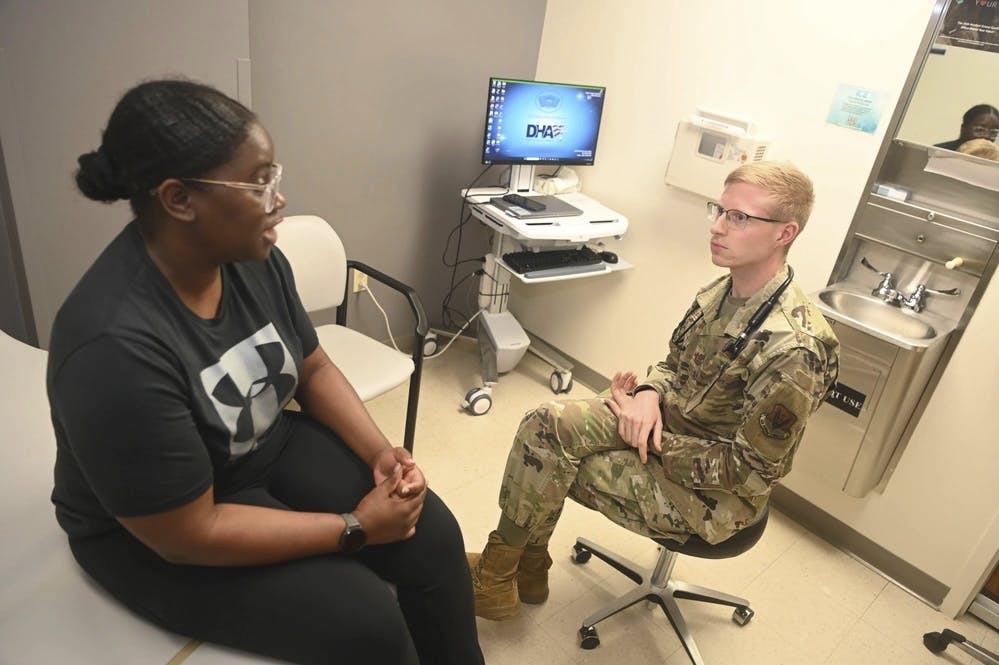Inside the HHS Budget Request to Boost Pandemic Preparedness, Equity
IT has a big role in HHS’s proposed budget to boost various responsibilities in public health management as well as access to health care.

The White House has proposed $127.3 billion in discretionary and $1.7 trillion in mandatory budget authority for the Department of Health and Human Services in fiscal year 2023. The budget aims to bolster public health emergency preparedness and infrastructure, research, as well as access, affordability and equity for physical and mental health care.
IT infrastructure and data modernization remain a key undercurrent to support these efforts, and the proposed budget carves out funding to support stronger IT and technological capabilities.
The White House aims to invest $6 million to the Food and Drug Administration to sharpen the safety and security of medical devices, overcome issues with legacy devices and drive resiliency into the medical device supply chain. It also provides $3 billion for IT at the Centers for Medicare and Medicaid Services (CMS) — including $646 million prioritized for enhancing cybersecurity and modernizing outdated Medicare payment systems.
Cybersecurity remains an overall focus for HHS across the budget, with the administration’s allocation of $161 million to strengthen the department’s cybersecurity posture — including $50 million to implement zero trust architecture and security logging.
The administration also provided the Office of the National Coordinator for Health IT $52 million to improve standards for increased interoperability and equity across health IT activities.
A bulk of HHS’s financial support for IT will also come from the Nonrecurring Expenses Fund, for which the White House has proposed $300 million to support IT and infrastructure projects across HHS — especially the Indian Health Service, National Institutes of Health (NIH) and Health Resource Services Administration (HRSA).
Funding for Pandemic Preparedness
The budget looks to continue supporting ongoing needs from the COVID-19 pandemic while also preparing for future pandemic preparedness. The White House allocated $81.7 billion in mandatory funding over the next five years across the Office of the Assistant Secretary for Preparedness and Response (ASPR), NIH, FDA and the Center for Disease and Control Prevention (CDC) to better address pandemic and public health emergencies.
The White House also requests $975 million for the Strategic National Stockpile — an increase of $130 million above the fiscal year 2022 enacted amount — and $22.5 billion overall to continue the immediate COVID-19 response.
“We face unavoidable impacts of not receiving these resources,” HHS Secretary Xavier Becerra told members of the House in a hearing last week. “Testing and treatment will decline. The uninsured fund — which offers coverage of testing, treatments and vaccinations for tens of millions of Americans who lack health insurance — will run out of money and stop paying provider claims. … Many Americans will no longer be able to access life-saving monoclonal antibodies and antiviral drugs. We will be unprepared for a new variant and unable to provide life-saving vaccines to the American people.”
Through the proposed budget, HHS will stand up a “Vaccines for Adults” program and expand the “Vaccines for Children” program through the CDC to enable longer-term accessibility of vaccinations.
Looking ahead, the White House requests funding to bolster public health infrastructure for emergencies. The administration requested $40 billion to ASPR to invest in advanced development and manufacturing of countermeasures to biological threats and infectious diseases, including vaccines, therapeutics, diagnostics and personal protective equipment. On the research side, the administration requests $2.1 billion for NIH to advance discoveries and development of vaccines, diagnostics and treatment.
The budget also looks to provide funding for public health and regulatory infrastructure modernization.
The CDC would receive $28 billion under the budget to enhance its public health system infrastructure.
$28 billion would go to the CDC to enhance its public health system infrastructure, national and international surveillance capabilities, public health workforce development, public health laboratory capacity and global health security. $200 million would also go toward CDC’s Data Modernization Initiative to improve data collection, management and use of public health data.
“The funding will also help facilitate an ‘equity-centered’ data system that improves data quality and makes data more complete, accessible and representative of all people,” HHS said of the initiative.
For the FDA, the White House included $1.6 billion to expand and modernize the agency’s regulatory capacity IT and laboratory infrastructure to accelerate evaluation of medical countermeasures.
Bolstering Biomedical Science and Research
The Biden administration looks to piggyback off biomedical advancements made during the pandemic and drive investments to foster better scientific research and development.
Spotlighted in this funding area is the prominent Advanced Research projects Agency for Health, or ARPA-H, for which President Joe Biden has been a large advocate. His administration carved out $5 billion to launch ARPA-H to drive advanced projects in cancer, infectious diseases, Alzheimer’s disease and other health conditions.
The White House wants to nest ARPA-H within NIH and would make its $5 billion allocation part of NIH’s overall $49 billion budget in discretionary spending.
Biden will increase spending for both the CDC and FDA to a total of $92 million to further advance cancer research through the Cancer Moonshot program, which aims to reduce the death rate of cancer by at least 50% over the next 25 years. This includes increases in funding to enhance CDC’s cancer-related programs and FDA’s Oncology Center of Excellence.
The proposed budget will also allocate $6.8 billion for FDA’s research and development of therapeutic drugs and biological products, as well as $527 million for the Agency for Healthcare Research and Quality to support evidence-based research, data and tools to drive safer, better quality health care.
Health Accessibility, Affordability and Equity
The White House aims to address various health care needs throughout its proposed HHS budget, with the underlying theme of reducing disparities, the cost of care and barrier to access.
Mental health and substance use disorder are two of the big pillars of improved care that Biden aims to address in his budget, with a total of $20.8 billion in discretionary funding in these areas across the entire department — or $4.9 billion above the fiscal year 2022 enacted level. Overall, Biden wants to allot $51.7 billion over 10 years for national mental health support.
This part of the budget includes a new $7.5 billion Mental Health System Transformation Fund over a 10-year period to increase access to mental health services through workforce development and service expansion and integration of quality mental health and substance use care into primary care settings. There will also be funding to build out the transition of the National Suicide Prevention Lifeline to 9-8-8 in July this year.
The budget also allocates $31 billion to expand access to behavioral health across the private insurance market, $20 billion to require coverage of three behavioral health and three primary care visits without cost-sharing, $7.5 billion to invest in the behavioral health workforce and service delivery and $7.5 billion to establish Medicaid provider capacity grants for mental health and substance use disorder treatment.
Beyond mental health, Biden aims to provide $11 billion to address the opioid crisis. His budget will also continue efforts to the HIV epidemic with $850 million in funding across CDC, HRSA, HIS and NIH — $377 million above last fiscal year’s enacted levels.
“The Budget also creates a national program that invests $9.8 billion over 10 years to provide a financing and delivery system to ensure everyone has access to pre-exposure prophylaxis, also known as PrEP, and essential wraparound services,” Becerra added.
The budget allocates funding for maternal and childcare and wellbeing too, providing $20.2 billion in discretionary funding for the Administration for Children and Families’ early care and education programs.
“This includes $12.2 billion for Head Start to provide services to more than a million children, pregnant women and families, $7.6 billion for the Child Care and Development Block Grant, and $450 million for Preschool Development Grants to increase capacity of states to expand preschool programs,” Becerra said.
The mandatory budget will include $4.9 billion in expanded services to prevent child maltreatment and the need for foster care, as well as an increased $3 billion for programs that stabilize and support families and adopted families.
The proposed budget will overall invest $470 million in funding across AHRQ, CDC, HRSA, NIH and IHS to reduce maternal mortality and morbidity. This will include increased funding for CDC’s Maternal Mortality Review Committees, HRSA’s State Maternal Health Innovations Grants program and more. The budget also carves out $42 million for the Office of Women’s Health to fund prevention initiatives and address health disparities in women.
By providing $3.1 billion for the Administration for Community Living, the administration hopes to support caregivers, older adults and people with disabilities to advance equitable access to care, education, employment and transportation as well.
To drive equity through Medicare and Medicaid, the administration allocates $35 million for CMS to launch a new initiative to systemically identify and resolve barriers to equity in each CMS program through research, data collection and analysis, stakeholder engagement and technical assistance. Becerra also said that the administration wants to support further extension of telehealth for more care accessibility.
“The administration is committed to supporting a temporary extension of broader telehealth coverage under Medicare beyond the declared COVID-19 public health emergency to study its impact on utilization of services and access to care,” Becerra told Congress.
Becerra also focused on improved funding for IHS, noting that the Biden administration aims to provide $9.3 billion to the agency in the upcoming fiscal year. This will include $147 million in current law mandatory funding for the Special Diabetes Program for Indians.
“This substantial funding increases of $2.5 billion above fiscal year 2022 enacted will support direct healthcare services, facilities and IT infrastructure, and management and operations,” Becerra said. “It also provides targeted increases to address key health issues that disproportionately impact American Indians and Alaska Natives such as HIV, Hepatitis C, opioid use and maternal mortality.”
Biden aims to increase IHS’s budget over the next 10 years to $36.7 billion in FY 2032 — an increase of 296% over the 10-year budget window. Becerra said over the next five years, funding for IHS will help modernize the IHS electronic health record system, reduce facility backlogs and fully fund the Federal-Tribal Indian health care Improvement Fund workgroup.
This is a carousel with manually rotating slides. Use Next and Previous buttons to navigate or jump to a slide with the slide dots
-

VA's Platform One Powers Rapid Innovation to Bolster Digital Services
VA's Platform One accelerates software development timelines from weeks to hours, ultimately enhancing digital services for veterans.
5m read -

Trump Executive Order Boosts HBCUs Role in Building Federal Tech Workforce
The executive order empowers HBCUs to develop tech talent pipelines and expand access to federal workforce opportunities.
3m read -

IHS Prepares to Deploy PATH EHR at Pilot Sites in 2026
IHS targets PATH EHR pilot in 2026, emphasizing governance, collaboration and interoperability as key pillars of the modernization strategy.
4m read -

FEHRM CTO Targets Two-Year Cloud Migration for Federal EHR
Lance Scott touts new EHR tech advancements, including cloud migration, expanded data exchange and AI integration to improve care delivery.
4m read








